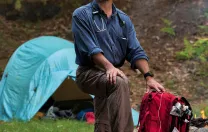The Massachusetts General Hospital wilderness-medicine division’s mission is threefold: clinical practice, teaching, and research. For years, Stuart Harris, division chief and an emergency-medicine physician, has focused on high-altitude sickness in its most serious forms: AMS (acute mountain sickness), HAPE (high-altitude pulmonary edema, an accumulation of fluid in the lungs, the most common cause of death from high-altitude illness), and HACE (high-altitude cerebral edema, a swelling of the brain—less common but more deadly). Altitude illness seems like a simple problem: when people ascend too quickly for their bodies to acclimate to decreasing levels of oxygen, they get sick; symptoms often begin with headaches, nausea, and vomiting. “The body responds to hypoxia”—the lack of oxygen—“as a life threat,” Harris explains, “as if a tiger were jumping out of the woods.” But although scientists know how to prevent altitude sickness (ascend slowly, don’t over-exert); the actual mechanism for the illness, he says, remains more mysterious.
“We know what much of the physiology is—essentially, a lack of oxygen,” Harris explains, “but we don’t understand what the pathophysiology is”—in other words, what goes wrong in the brain because of this lack of oxygen. And there are reasons besides scientific curiosity to figure it out: “By studying how low oxygen states affect the organism, the organs, the organelles, you know a lot more about the things we treat every day at sea level in the MGH emergency department. Acute heart attack is a sudden loss of oxygen to the heart muscle; acute stroke is the same thing for the brain. And most pulmonary processes are essentially variations on the hypoxic theme.” In the mountains of Nepal this past spring, fellows from the division, as part of a study on altitude’s effect on the brain, carried with them small handheld ultrasounds, which they used to examine climbers’ and trekkers’ optic nerves for swelling, to see whether that swelling corresponded to an altitude-related effect his team recently discovered, a potential decline in cognitive function. Meanwhile, at MGH, Harris has been collaborating with other scientists on research that simulates high-altitude conditions in study subjects to investigate hypoxia as a potential therapy for mitochondrial diseases. Mouse models have shown a benefit.
One major project uniting all Harris’s altitude work is an effort to develop a rigorous and objective way to diagnose AMS, one that can pinpoint the depth and spread of the disease. Currently, it’s diagnosed only by its symptoms—a highly subjective measure, Harris says, which he would supplement with blood tests for biomarkers and perhaps ultrasound imaging of the optic nerve sheath.
More recently, the division has taken on research and advocacy related to climate change. This springs from Harris’s lifelong upbringing and education in the outdoors, and more proximally, from his partnership with Woods Hole Research Center’s Max Holmes, an earth-system scientist who studies the effects of climate change in rivers, watersheds, and arctic permafrost. Climate change is also a particular interest of emergency physician Renee Salas, the division’s assistant fellowship director—her passion, Harris says, has helped drive this project. Climate change is already being felt, she explains, and, increasingly, the coming decades will bring related public-health emergencies: natural disasters, increased pollution, heat waves, heat injuries, asthma, and infectious diseases moving into environments where they have never existed. “And these people are going to be presenting in emergency departments,” she says. “When people have asthma exacerbations because of increased pollen and smog events, you’re going to come to the ED. When there’s severe weather and there’s injuries, you’re coming to the ED. When people are having increased heart attacks because of smog—ED. Waterborne illnesses and outbreaks.…We’re the safety net of the healthcare system.” And many acute events will also happen far away from hospitals and emergency departments. “There are especially vulnerable populations that exist outside of settled infrastructures,” Salas points out—but infrastructures themselves, she warns, “are going to be displaced. The biggest thing we can do is figure out ways to help them adapt.”









